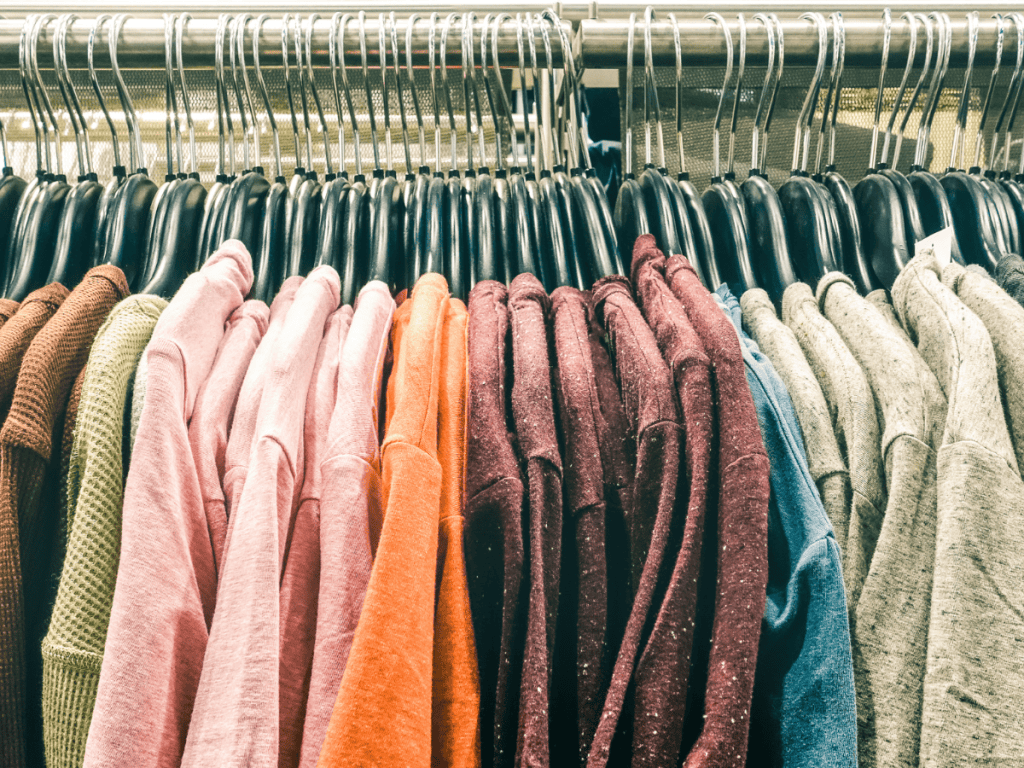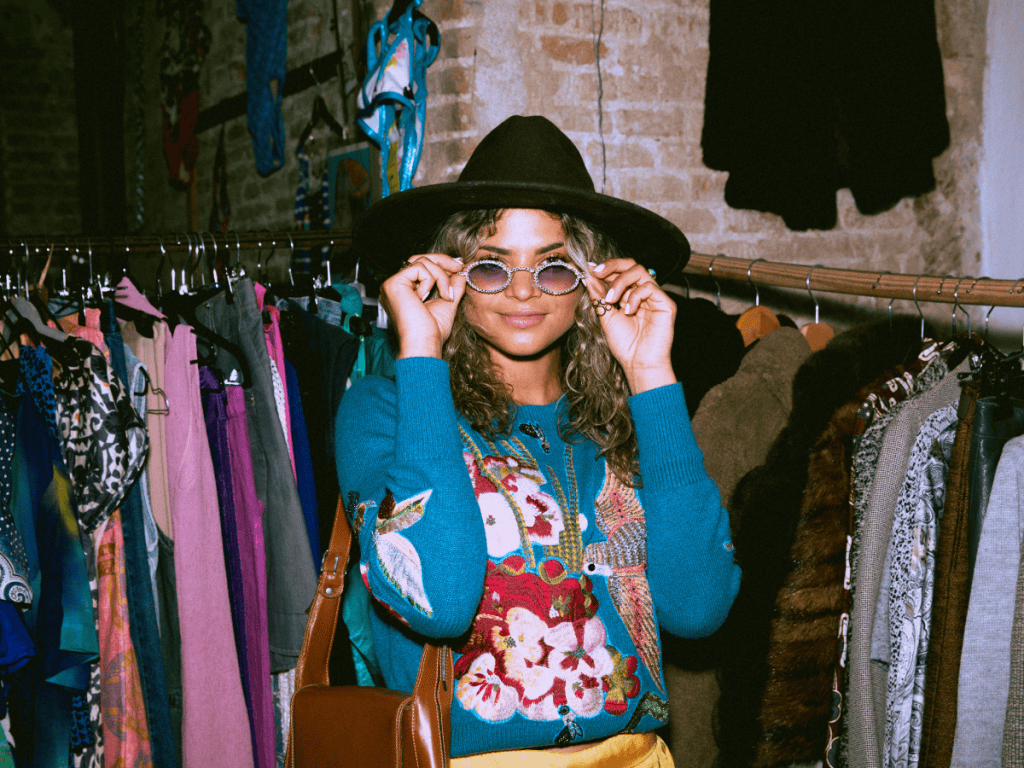Thrifting has become an integral part of sustainable fashion, but it’s crucial to know how to wash thrifted clothes before wearing or storing them. Since thrift stores do not wash donations, the responsibility to disinfect thrift store clothes falls on the shopper.
To ensure your secondhand items are safe and clean, start by sorting your thrift store clothing items by fabric type and color. I suggest you always read the care instructions carefully, as some thrifted items may require hand washing or dry cleaning, which can be gentle on fabrics and prevent damage to the material.
Preparation Is Key: Getting Ready to Wash Thrifted Finds
Before you start the washing process, it’s important to prep your garments. First, check for any special care labels, especially when dealing with items from an online thrift store, as these may not have been screened for washing instructions. I suggest you look for any loose buttons or seams that might need securing to prevent further damage during the wash cycle.
Empty all pockets and shake out the clothes to remove any dust or debris that could spread during washing. When you prepare to wash thrifted clothes, consider the fabric and the level of cleaning needed. For sturdier items, a cycle with cold or warm water in the washing machine may suffice, but delicate hand clothing items benefit from careful hand washing.
Next, sort your clothes by color and fabric type. This helps to avoid any dyes transferring during the wash and ensures that each item is cleaned according to its specific needs. Dark and light colors should be separated, and heavily soiled clothes might need to be washed alone or pre-treated to avoid contaminating other garments. With your thrifted finds sorted and prepped, you’re ready to move on to the next steps of the cleaning process.
The Sanitization Process: Ensuring Your Thrifted Clothes Are Safe
Sanitization is a critical step to disinfect thrift store clothes and ensure they are safe to wear. Begin by hand washing items that cannot withstand the agitation of a machine or require more delicate care. In my opinion, for machine-washable secondhand items, use a cycle with cold or warm water, depending on the fabric’s tolerance. Always follow the instructions carefully when adding sanitizing agents, like bleach or borax, to avoid damaging the clothes or causing any adverse reactions when the clothes are worn.
How to Wash Thrifted Clothes- Step by Step Guide
Effective disinfection of secondhand clothing is essential to ensure your new-to-you clothes are safe and ready for use. Start by separating thrifted clothing from vintage clothing, as vintage items may require more delicate handling.
For regular secondhand clothing, a pre-wash soak in a disinfecting solution can help eliminate bacteria and viruses. When cleaning thrift store clothes, it’s important to ensure that the clothes are clean and free from any agents that could cause skin irritation.
For tougher germs, consider using a laundry sanitizer that’s safe for the fabric you’re treating. Some disinfectants are specifically designed for use at lower temperatures, making them suitable for both cold and warm washes. Always check the care labels on vintage and secondhand clothing before adding sanitizing products to avoid damaging these garments. Proper disinfection allows you to confidently incorporate your thrifted and vintage items into your wardrobe.
1. Pre-Treat Stains and Spots
When dealing with stains and spots on your thrifted finds, pre-treatment is key to ensuring they don’t set in. Gently dab the affected area with a damp cloth to lift as much of the stain as possible before washing. For more stubborn marks, apply a small amount of stain remover and allow it to penetrate the fabric for a few minutes. If you’re dealing with delicate fabrics, test the stain remover on a hidden area first to ensure it doesn’t cause discoloration or further damage.
Remember that the sooner you address stains, the more likely you are to remove them completely. Trust me from experience, I suggest you avoid rubbing the fabric harshly, as this can spread the stain or damage the material. After pre-treating, proceed with the recommended wash method, whether it’s hand washing or using a machine, and inspect the garment afterward to ensure the stain has been fully removed.
2. Neutralizing Odors with Natural Substances
Secondhand clothing often comes with lingering odors that regular detergent alone may not eliminate. To tackle these smells, incorporate natural substances such as baking soda or distilled white vinegar into your laundry routine. Add a cup of vinegar during the rinse cycle, or sprinkle baking soda into the drum before adding your clothes. These natural odor neutralizers help break down and absorb the smells without leaving a residue.
Allow your secondhand clothing to air out in a well-ventilated laundry room or outdoor space after washing. Fresh air can further help in removing any remaining odors, leaving your clothes smelling clean. By using these natural methods, you avoid harsh chemicals while still achieving odor-free garments, perfect for those who prefer shopping secondhand for its eco-friendly benefits.
3. Killing Bacteria and Parasites in Fabrics
Sanitizing your thrifted clothes is a vital step in ensuring they are free from harmful bacteria and parasites. For synthetic fabrics and other durable materials, wash in a machine with a disinfectant suitable for laundry use. These products are designed to kill microorganisms without damaging the fabric. I would recommend you always follow the manufacturer’s guidelines for the correct amount to use and the best wash cycle to pair it with.
For items that cannot be washed in a machine, such as certain vintage textiles, consider hand washing with a gentle disinfecting solution. Take extra care with agitation and rinsing to avoid damage while still ensuring thorough sanitization. Whether you choose hand washing or machine washing, ensure the clothes are completely dried afterward, as moisture can promote the growth of bacteria and mold.

Best Practices for Washing Different Types of Vintage Clothes
Vintage clothes require special attention during the cleaning process to preserve their unique qualities. Hand washing is often the safest method to protect the fabric’s integrity and prevent damage. I suggest using a gentle, pH-neutral detergent to help maintain the color and texture of the garment. For materials like silk or wool, cool water is preferable, and garments should be laid flat to dry to avoid misshaping. It’s important to remember that vintage pieces can be delicate, so handling them with care during the washing cycle is paramount.
The Washing Routine: A Step-By-Step Guide to Cleaning Thrifted Clothes
When cleaning thrifted clothes, a structured routine ensures that each garment receives proper care. Here’s my tried-and-tested method: begin with hand washing pieces that require gentle treatment or have embellishments that could be damaged in a machine. For pre-treating grease stains, apply a small amount of detergent directly to the stain and gently rub it in. Fill a clean sink or basin with water, add 1 cup of mild detergent, and submerge the garment, gently agitating it to loosen any dirt. After rinsing thoroughly, press out excess water without wringing and lay flat to dry.
Step-By-Step Instructions for Different Wash Methods
For machine washing sturdier thrifted items, first, turn garments inside out to protect the outer surface. Select a gentle cycle and fill the machine with the appropriate water level. Add your regular laundry detergent along with a cup of vinegar to the rinse cycle to help remove any lingering odors and soften the fabric. Before adding stain removers to heavily soiled areas, make sure they are compatible with the fabric to avoid any adverse reactions. After the wash cycle, check stains before drying, as heat can set them permanently.
Hand Washing Delicate Items
Delicate vintage items often benefit from the gentle approach of hand washing. Fill a basin with lukewarm water and a suitable detergent designed for delicate fabrics. Submerge the item, gently swish it in the water to release dirt, and avoid scrubbing or twisting, which can damage fragile materials. Rinse thoroughly with water of the same temperature to prevent thermal shock. Squeeze out excess water gently, then lay the item on a clean, dry towel, rolling it up to absorb moisture before laying it out to air dry.
Machine Washing Sturdy Garments
Machine washing is appropriate for sturdier thrifted garments such as cotton shirts and denim. Use a gentle cycle with cold water to prevent shrinkage and color bleeding. Separate lights and darks to maintain color integrity.
For extra precaution, place items in a mesh laundry bag to avoid snagging. Once the cycle is complete, remove clothes promptly to prevent wrinkles and hang them to dry, or if the garment allows, use a low-heat dryer setting to avoid over-stressing the fabric.

Tackling Tough Stains with Effective Solutions
When dealing with tough stains on thrifted clothes, pre-treatment is essential. Apply a generous amount of stain remover to the affected area and allow it to sit for a few minutes before washing. This time allows the solution to break down the stain’s molecular bonds, making it easier to wash out. An enzyme-based stain remover is particularly effective for organic stains like blood or wine. Always follow the manufacturer’s instructions for the best results, and rinse thoroughly before proceeding with the main wash cycle.
Odor Removal Techniques for Fresh-Smelling Clothes
Shopping secondhand can sometimes mean encountering stubborn odors. To remove these, create a solution of equal parts water and hydrogen peroxide in a spray bottle. Generously mist the affected areas and allow the mixture to sit for 15 minutes before laundering.
Distilled White Vinegar for Persistent Smells
Distilled white vinegar is a powerful ally against persistent smells in thrifted clothing. In my home, before washing, we soak the garment in a mixture of one part vinegar and four parts water for 30 minutes. This helps to neutralize tough odors and can also soften fabrics without the use of harsh chemicals. After soaking, wash the garment as usual, and the smell should be noticeably reduced, if not eliminated, leaving your thrifted finds fresh and ready to wear.
Baking Soda to Absorb Unwanted Odors
To tackle unwanted odors, sprinkle baking soda liberally over the dry garment, focusing on areas that are prone to sweating, such as the underarms or collar. I recommend you allow the baking soda to sit on the fabric for at least an hour or overnight for stronger odors. The baking soda works by absorbing and neutralizing the smell. Once the time has passed, shake off the excess powder and proceed with your regular washing routine to reveal clothes that smell as clean and fresh as they look.
Drying Strategies to Maintain Fabric Integrity
Proper drying is crucial for maintaining the integrity of thrifted clothes, especially for synthetic fabrics that can warp or shrink under high heat. For these materials, air drying is the safest method. If using a dryer, opt for a low heat setting and remove the garments while still slightly damp to prevent damage.
For heavier synthetic fabrics, tumble dry on a gentle cycle to minimize wear and tear. Always refer to the care label for specific drying instructions to ensure garments retain their shape and texture.

Maintenance After Washing: Keeping Your Thrifted Clothes in Prime Condition
After laundering, maintaining thrifted clothes involves proper storage and occasional dry cleaning, particularly for vintage clothes with delicate fibers.
Fold or Hang? Deciding the Best Storage Method
The drying method can greatly influence the longevity of clean thrift store clothes. From my experience, delicate items should be laid flat to air dry to prevent misshaping, while sturdier garments can be hung. However, even with hanging, ensure that the weight of the wet fabric does not damage the fabric by stretching it out. Once dry, folding is preferable for knitwear and stretchable materials to keep them from losing their form, while structured items like blazers and dresses are best kept on hangers.
Ironing Tips for Thrifted Fabrics
Ironing thrifted clothes can help eliminate lingering odors and give your garments a crisp, fresh appearance. For clothes prone to odors, consider using a homemade spray of equal parts water and white vinegar while ironing.
Not only will this mixture help to release wrinkles, but the vinegar will also aid in neutralizing any remaining smells without damaging the fabric. Always test a small, inconspicuous area first to ensure the iron’s heat and the vinegar spray do not have adverse effects on the thrifted fabric.
Conclusion
To maintain the allure of your thrift store finds, it’s crucial to treat them carefully after cleaning them. Second-hand clothes can be treasures that stand the test of time if handled correctly. Always check the care label before you wash your clothes, adhering to the recommended washing cycle and heat setting. This cleans the garment and helps keep its original shape and color, which is particularly important for newly purchased vintage pieces from thrift shops.
After washing, I always suggest adding a splash of vinegar to the rinse cycle, which can work wonders in preserving fabric quality and preventing future odors. With these practices, you can enjoy the enduring elegance of your unique finds, making them a lasting part of your wardrobe.